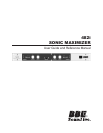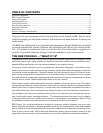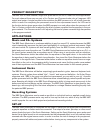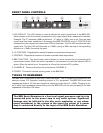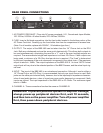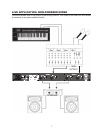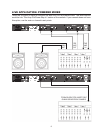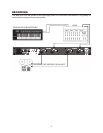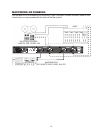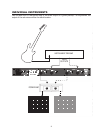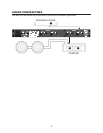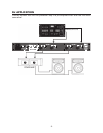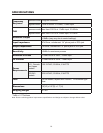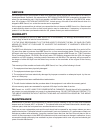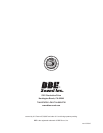
3
TABLE OF CONTENTS
Important Safeguards ……………………………………………………………………………………………… 2
BBE Process Explained …………………………………………………………………………………………… 3
Product Description ………………………………………………………………………………………………… 4
Applications/Set Up ………………………………………………………………………………………………… 4
Front Panel Controls ……………………………………………………………………………………………… 5
Rear Panel Connections …………………………………………………………………………………………… 6
Application Diagrams ………………………………………………………………………………………… 7-13
Specications …………………………………………………………………………………………………… 14
Service / Warranty / Maintenance ……………………………………………………………………………… 15
Thank you for your purchase, and for the trust that you’ve placed in BBE. We are com-
mitted to bringing you the nest products, with useful and unique features to serve your
audio needs.
The BBE Sonic Maximizer is a 2-channel signal processor that will benet any recording
or sound reproduction system. Whether you purchased the 482i for your home studio,
P.A., DJ system, or instrument rack, you will nd the Sonic Maximizer’s rugged con-
struction and careful electronic design a welcome addition to your sonic arsenal.
THE BBE PROCESS — “WHAT IT IS”
Loudspeakers have difculty working with the electronic signals supplied by an amplier. These
difculties cause such major phase and amplitude distortion that the sound reproduced by a
speaker differs signicantly from the sound produced by the original source.
In the past, these problems proved unsolvable and were thus delegated to a position of sec-
ondary importance in audio system design. However, phase and amplitude integrity is essential
to accurate sound reproduction. Research shows that the information which the listener trans-
lates into the recognizable characteristics of a live performance are intimately tied into complex
time and amplitude relationships between the fundamental and harmonic components of a given
musical note or sound. These relationships dene a sound’s “sound”.
When these complex relationships pass through a speaker, the proper order is lost. The higher
frequencies are delayed. A lower frequency may reach the listener’s ear rst or perhaps simulta-
neously with that of a higher frequency. In some cases, the fundamental components may be so
time-shifted that they reach the listener’s ear ahead of some or all of the harmonic components.
This change in the phase and amplitude relationship on the harmonic and fundamental frequen-
cies is technically called “envelope distortion.” The listener perceives this loss of sound integrity
in the reproduced sound as “muddy” and “smeared.” In the extreme, it can become difcult to tell
the difference between musical instruments, for example, an oboe and a clarinet.
BBE Sound, Inc. conducted extensive studies of numerous speaker systems over a ten year
period. With this knowledge, it became possible to identify the characteristics of an ideal speaker
and to distill the corrections necessary to return the fundamental and harmonic frequency struc-
tures to their correct order. While there are differences among various speaker designs in the
magnitude of their correction, the overall pattern of correction needed is remarkably consistent.



